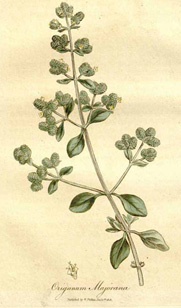Marvelous Marjoram
By Audrey Stallsmith

“And bury me in Saint Mary’s church
All for my love so true,
And make for me a garland of marjoram,
And of lemon-thyme, and rue.”
Lady Alice (ballad)
Since a recipe I intend to use for Thanksgiving stuffing this year calls for poultry seasoning, I looked up that seasoning to see whether I already had all the herbs and spices included in it. As luck would have it, I possessed thyme, sage, rosemary, pepper, and nutmeg, but lacked one ingredient--marjoram.
Sweet marjoram (Origanum majorana) actually is a less intense version of oregano, with which it shares the genus name Origanum. The extremely hardy oregano, in fact, often is called "wild marjoram," the outlaw of the clan. The milder, sweeter, more tender majorana is the “lady.”
Due to their shared family name, a combination of the Greek oros or oreos (“mountain”) and ganos or ganeos (‘joy”), both herbs have been known as “mountain joy.” (Some chocolate lovers might think that oreos should stand for joy, but that’s not the way it goes!)
Often associated with Venus and Aphrodite, the two plants thus represent romantic love and happiness, as in the ballad quoted above. Granted, the song wasn’t particularly happy, because Lady Alice died of grief a day after hearing of her lover’s death. But, hey, that’s either true love or true lunacy!
So Greek couples often wore marjoram headdresses at their wedding, and the herb also was likely to appear in a young woman’s hope chest—and under her pillow to help her dream of her future mate. It also supposedly prevents milk from being soured by thunder. But, since I’ve never noticed thunder “turning” our milk, I doubt I’ll require it for that purpose!
Often considered a heal-all in the ancient world, marjoram does seem to improve the digestion, relive menstrual cramps, and slow the growth of the herpes virus. In E. Nesbit’s, The Story of the Treasure Seekers, Alice brewed herb tea to treat Noel’s cold. “She got sage and thyme and savory and marjoram and boiled them all up together with salt and water.” According to the story, “the medicine did not seem to do the cough any good.”
I probably could have substituted half the amount of oregano for marjoram if I wanted to make my own poultry seasoning. But I decided it was easier for a mathematically challenged person such as myself to just buy that seasoning rather than trying to figure out all the percentages involved. After all I'm going to have a hard enough time stuffing the turkey, not to mention stuffing the ten-pound bird into a roasting bag meant for eight pounds.
Besides, as Michael Castleman points out in The Healing Herbs, oregano and marjoram get confused with each other so often that my oregano actually might be marjoram. And that would throw my calculations off considerably!
The Origanum majorana image is from the third edition of Medical Botany by W. Woodville, W. J. Hookert, and G. Spratt, courtesy of plantillustrations.org.








